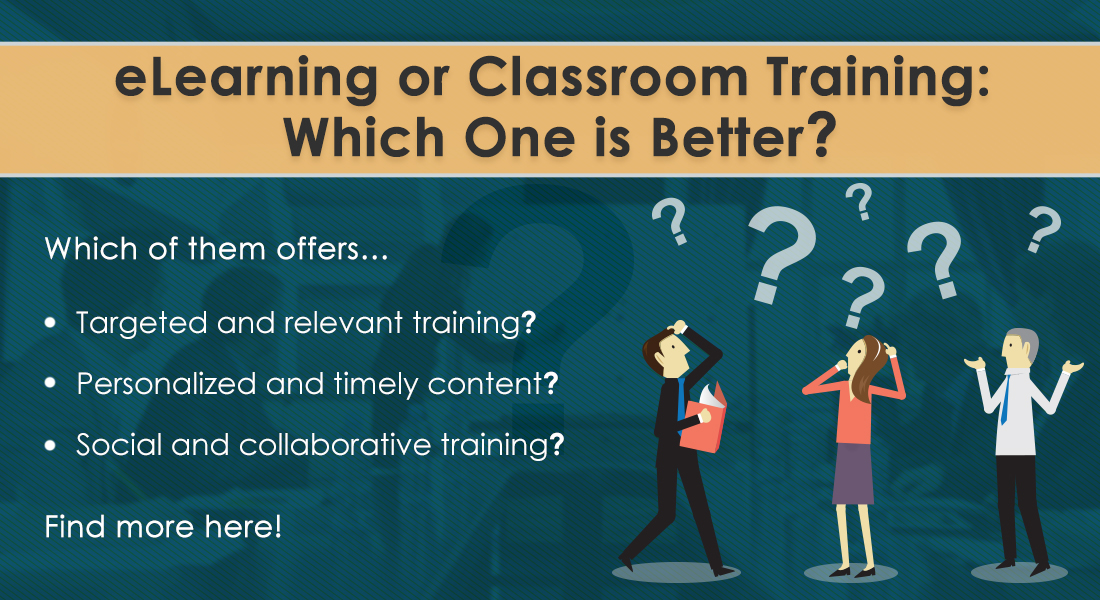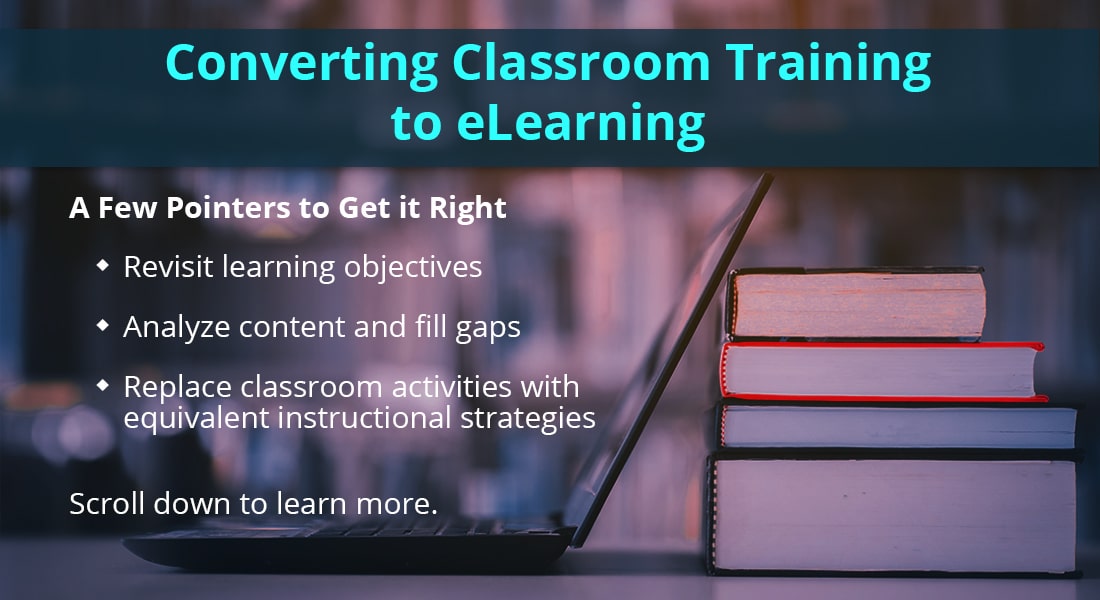The Battle of eLearning vs Classroom Training: Who’s the Winner?

Are you still wondering whether you should switch from in-person classroom training to eLearning? To be honest, online training has never been more widely used for workplace training than today. ELearning currently makes up 21 to 40% of the median organization’s learning portfolio compared to 1 to 20% five years ago. In fact, “In another five years, the median organization anticipates delivering between 41 and 60 percent of its learning portfolio as e-learning” (ATD).
ELearning vs. Classroom Training 101: 5 Points of Comparison
- Targeted and relevant training
- Personalized and timely content
- Social and collaborative learning
- Scalable and fail-safe training approach
- Measurable results and in-depth reporting
Let’s now consider your most pressing question about eLearning.
Is eLearning as good as in-person classroom training?
Yes! If done right, online training can be more effective than classroom training. For instance, eLearning is a better choice to make learners understand concepts than making them attend hour-long face-to-face sessions.
Having said that, 42% learners still prefer to learn in a classroom with a group, if possible (Statista). This is an indication that it is unlikely that online training will completely replace classroom training. Nevertheless, eLearning is here to stay, and organizations are increasingly looking at eLearning with no imminent plans to invest more in classroom training. According to a recent Brandon Hall report, 0% organizations plan to increase in-person training in the next 12 months.
With this background, let’s explore how online training fares against classroom training.
Explore how to migrate classroom training materials to eLearning like a pro!
Online Training vs. Classroom Training: 5 Points of Comparison
1. Targeted and Relevant Training
According to a report by Deloitte, an average US worker spends 25% of the day reading or answering mails. Mobile phone users, on average, check their devices 150 times a day. Added to that, employees face interruptions 56 times in a day!
With all this, the average time an employee has for training and development in a week is around 24 minutes (Forbes) – a mere 1%! Looking at these numbers, it is no wonder learners are looking for timely and targeted content.
Do you think only in-person classroom training would cater to the demands of the modern-learner? Perhaps not! Long training sessions equals time away from work and delays in schedules. In addition, a one-off training session doesn’t always translate to effective on-the job application, because of the lack of accessible learning resources for reinforcing what was learned in the formal training session.
Enter eLearning!
Online training can be done anytime, anywhere – even while on coffee breaks or vacations. Learners can complete a training module without having to step out of their office or home – saving on traveling time to reach the training venue. Unlike classroom training, learners go through what they need the most to fill knowledge gaps or hone skills – targeted and succinct. They have the added advantage of going through some sections as many times as they need while skipping others they know already. Learners can pause, resume, and finish an eLearning course at their own pace – benefits that in-person classroom training does not offer.
2. Personalized and Timely Content
Relevance is hero. Most of the learning at the workplace is done at the moment of need. According to a research by Google, 96% of people use their smartphones to help them get things done in moments of need. What’s more, people are increasingly looking for relevance and quality. They look for the most useful information and strip out what’s not useful for them.
With in-person classroom training, the approach is often one-size-fits-all. Learners are made to learn what is thought to be relevant and important for a group of learners. However, what might be new for a set of learners might be known to others already. In addition, there is a greater chance of learners forgetting the learning and not applying it to their jobs effectively.
eLearning, on the other hand, has the ability to offer learners personalized learning paths that allow them to have unique learning experiences, based on their preferences and needs. In addition, online training extends the accessibility of learning resources to mobile devices, ensuring learners have information at their point of need. Mobile learning modules are especially beneficial for the on-the-go workforce who spend most of their working day in the field.
So, whether it is learning for the first time, continuous learning, or at the moment of need learning, mobile learning caters to all learning requirements of your modern learners.
3. Social and Collaborative
Those new to online training often assume that the biggest drawback of online training is the absence of collaboration and interaction among learners. That is a valid concern because social interaction is vital to learning. In fact, 87% employees think social knowledge sharing is essential to learning.
You might think in-person social interactions are hard to replicate in the digital realm, but when it comes to corporate training, it is quite the opposite. Unlike in-person social learning activities, online platforms offer the convenience of anytime anywhere collaborations which is unmatched in the present times, especially with remote working being the new normal. How?
Here are several ways learners can interact and collaborate in online training:
- Tools like Google+ Hangout, Microsoft Teams, Skype, GoToMeeting can be used for video conferencing – weekly meetups, knowledge sharing sessions, and more.
- Social media sites such as LinkedIn, Twitter, Facebook, Google+ can be used to set the ball rolling for interactions on forums and discussion boards.
- Gamification elements in the eLearning program can be used to encourage social interactions and competition – for instance, leaderboards with a point system, virtual rewards for weekly toppers, and so on.
- Q&A sessions on the LMS (Learning Management System) can help learners to clear doubts with Subject Matter Experts (SMEs) or colleagues. The questions and answers can be compiled and offered to learners as a FAQ document for future reference.
- Real-time social interactions can be replicated in virtual instructor-led training sessions using whiteboards, breakout rooms, etc.
4. Scalable and Fail-safe Training Approach
Unlike classroom training where there is a limit to the number of learners you can reach in a session, online training allows you to rollout courses to any number of learners. Moreover, scaling up training in terms of course development is much easier and faster with eLearning than in-person training where you need to consider additional logistical factors such as availability of trainers, venue, travel, etc.
You can also opt for rapid eLearning solutions which enable quick program rollout, within budget, and without compromising on quality. How?
- Using available, existing content reduces time for content creation.
- An agile design and development process eliminates costly rework.
- In-built assets (templates, interactivities) of rapid eLearning authoring tools help speed up the development.
- Standardization saves time and cost by reusing elements, such as layouts for common screens, global instructions, etc.
While it might take months to create one instructor-led classroom training program, rapid eLearning courses can be rolled out within weeks, saving 40% of the development time. So, whether it is repurposing existing learning resources or migrating classroom training to eLearning, rapid eLearning development offers effective solutions for all training needs with the 4 ‘R’ strategies – Record, Republish, Rebuild, and Redesign.
In addition, online training is arguably the most fail-safe training approach, especially after the pandemic. So much so that 68% organizations are considering eLearning as a sustainable alternative to classroom training (Brandon Hall).
5. Measurable Results and In-depth Reporting
“How effective was the training?” should be the question every organization needs to ask. Because an investment is only worth it if it brings in the desired returns, in this case, helping achieve business goals.
When training takes place online, it’s easy to pull the data you need to measure its effectiveness. Information like course completion rates, assessments results, engagement and course completion time, can all be gathered in the form of reports directly from your new-age LMS.
In addition, you can even leverage the latest learning trends, such as adaptive learning and measure its outcomes using an LMS when your training is online. The LMS can also be connected with learning analytics tools to gather in-depth actionable data, from descriptive, diagnostic, predictive, to prescriptive.
Wrapping It Up!
In-person classroom training might not be the best option in these COVID times. Now that you are done with firefighting the initial aftermath of the outbreak, it is time to future proof your organization’s training. A successful online training blend is the solution – eLearning, VILT, hybrid blended approach, mobile learning, microlearning, and numerous other digital learning assets.
In the debate between classroom training vs. eLearning, the latter is the sure winner for us! ELearning is trending and it will continue to do so – pandemic or no pandemic.
Want to know what else is trending this year in L&D? Download this eBook and find out eLearning trends for enhanced performance, results and ROI.





![Migrating from ILT to eLearning? 6 Instructional Design Strategies to WOW Your Learners! [SlideShare]](https://blog.commlabindia.com/hubfs/Imported_Blog_Media/classroom-training-elearning-conversion-strategies-slideshare.jpg)